Case Formulation: Delusional Disorder in 'Lars and the Real Girl'
VerifiedAdded on 2022/12/15
|6
|1646
|174
Project
AI Summary
This assignment presents a case formulation of delusional disorder, drawing from the movie 'Lars and the Real Girl.' It explores the biological, psychological, and social factors contributing to the character's condition, including social anxiety, denial, and the role of his environment. The assignment delves into the diagnostic criteria based on DSM-5, identifying the specific type of delusional disorder exhibited and discussing instances that align or diverge from the diagnostic manual. It also addresses the movie's portrayal of stigma associated with mental illness, analyzing how the community's response to the character's delusion influences his well-being. The analysis provides a comprehensive understanding of the disorder, its manifestation, and the societal implications portrayed in the film, while also acknowledging the limitations of using a movie as a definitive standard for evaluating the condition.
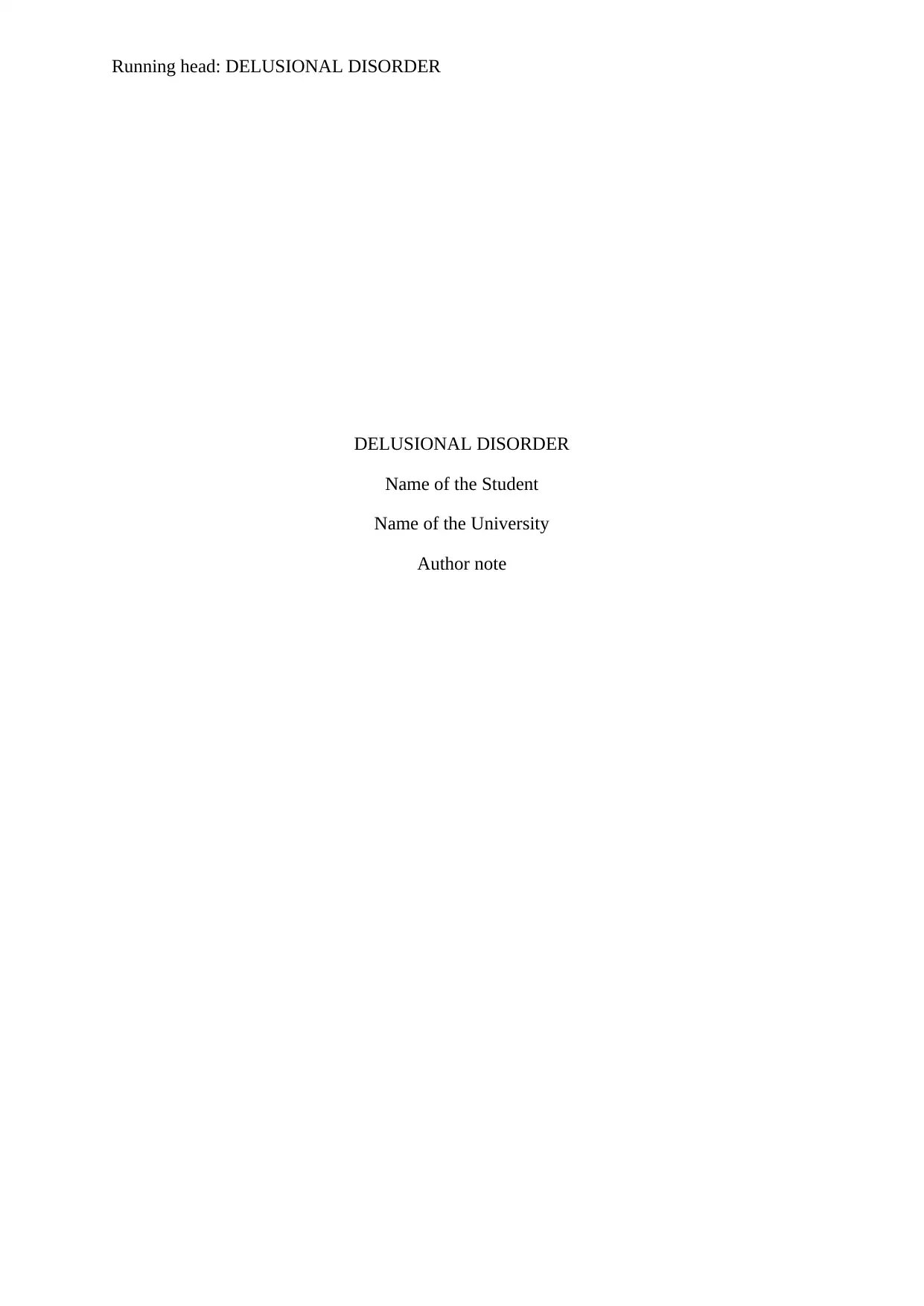
Running head: DELUSIONAL DISORDER
DELUSIONAL DISORDER
Name of the Student
Name of the University
Author note
DELUSIONAL DISORDER
Name of the Student
Name of the University
Author note
Paraphrase This Document
Need a fresh take? Get an instant paraphrase of this document with our AI Paraphraser
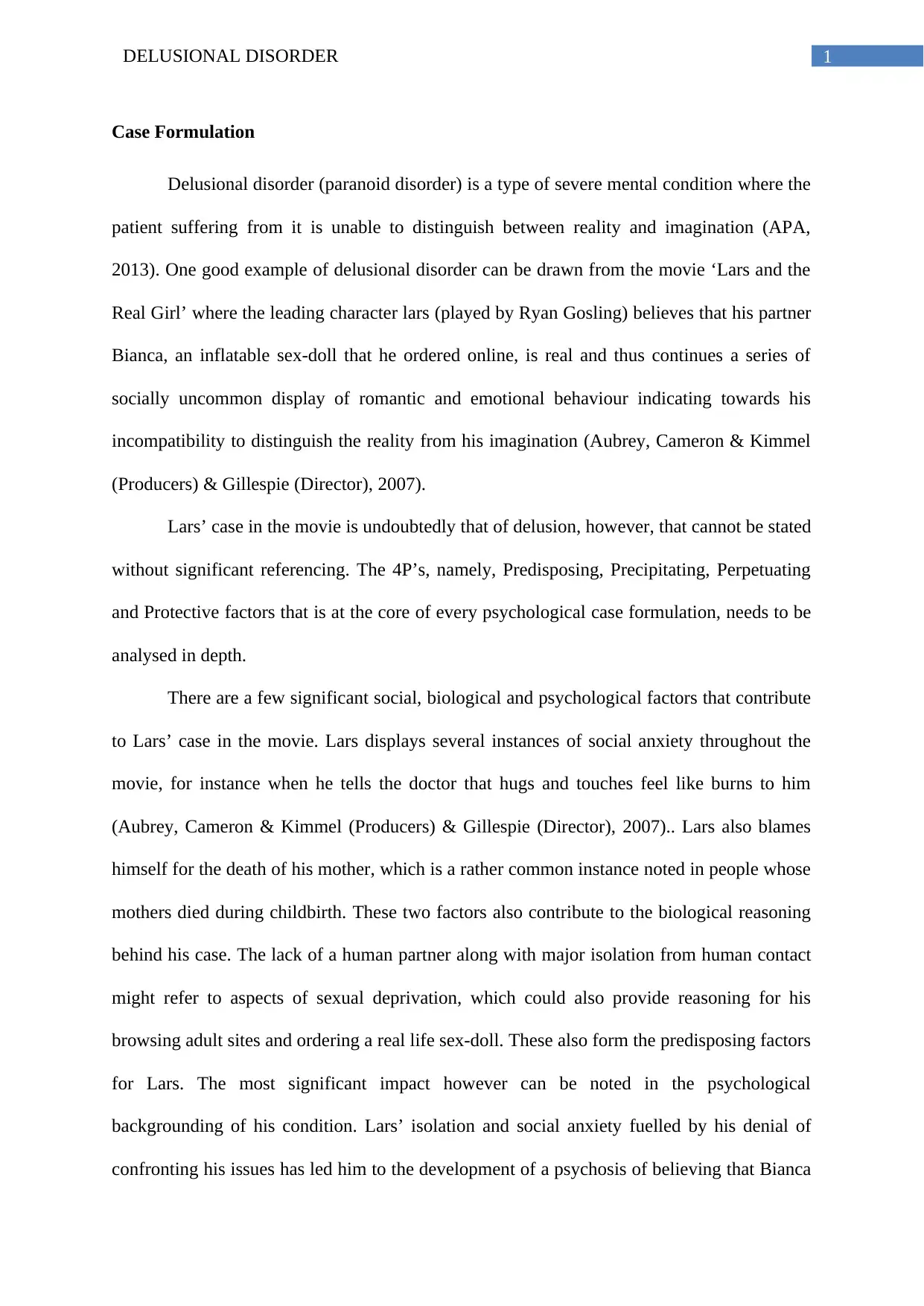
1DELUSIONAL DISORDER
Case Formulation
Delusional disorder (paranoid disorder) is a type of severe mental condition where the
patient suffering from it is unable to distinguish between reality and imagination (APA,
2013). One good example of delusional disorder can be drawn from the movie ‘Lars and the
Real Girl’ where the leading character lars (played by Ryan Gosling) believes that his partner
Bianca, an inflatable sex-doll that he ordered online, is real and thus continues a series of
socially uncommon display of romantic and emotional behaviour indicating towards his
incompatibility to distinguish the reality from his imagination (Aubrey, Cameron & Kimmel
(Producers) & Gillespie (Director), 2007).
Lars’ case in the movie is undoubtedly that of delusion, however, that cannot be stated
without significant referencing. The 4P’s, namely, Predisposing, Precipitating, Perpetuating
and Protective factors that is at the core of every psychological case formulation, needs to be
analysed in depth.
There are a few significant social, biological and psychological factors that contribute
to Lars’ case in the movie. Lars displays several instances of social anxiety throughout the
movie, for instance when he tells the doctor that hugs and touches feel like burns to him
(Aubrey, Cameron & Kimmel (Producers) & Gillespie (Director), 2007).. Lars also blames
himself for the death of his mother, which is a rather common instance noted in people whose
mothers died during childbirth. These two factors also contribute to the biological reasoning
behind his case. The lack of a human partner along with major isolation from human contact
might refer to aspects of sexual deprivation, which could also provide reasoning for his
browsing adult sites and ordering a real life sex-doll. These also form the predisposing factors
for Lars. The most significant impact however can be noted in the psychological
backgrounding of his condition. Lars’ isolation and social anxiety fuelled by his denial of
confronting his issues has led him to the development of a psychosis of believing that Bianca
Case Formulation
Delusional disorder (paranoid disorder) is a type of severe mental condition where the
patient suffering from it is unable to distinguish between reality and imagination (APA,
2013). One good example of delusional disorder can be drawn from the movie ‘Lars and the
Real Girl’ where the leading character lars (played by Ryan Gosling) believes that his partner
Bianca, an inflatable sex-doll that he ordered online, is real and thus continues a series of
socially uncommon display of romantic and emotional behaviour indicating towards his
incompatibility to distinguish the reality from his imagination (Aubrey, Cameron & Kimmel
(Producers) & Gillespie (Director), 2007).
Lars’ case in the movie is undoubtedly that of delusion, however, that cannot be stated
without significant referencing. The 4P’s, namely, Predisposing, Precipitating, Perpetuating
and Protective factors that is at the core of every psychological case formulation, needs to be
analysed in depth.
There are a few significant social, biological and psychological factors that contribute
to Lars’ case in the movie. Lars displays several instances of social anxiety throughout the
movie, for instance when he tells the doctor that hugs and touches feel like burns to him
(Aubrey, Cameron & Kimmel (Producers) & Gillespie (Director), 2007).. Lars also blames
himself for the death of his mother, which is a rather common instance noted in people whose
mothers died during childbirth. These two factors also contribute to the biological reasoning
behind his case. The lack of a human partner along with major isolation from human contact
might refer to aspects of sexual deprivation, which could also provide reasoning for his
browsing adult sites and ordering a real life sex-doll. These also form the predisposing factors
for Lars. The most significant impact however can be noted in the psychological
backgrounding of his condition. Lars’ isolation and social anxiety fuelled by his denial of
confronting his issues has led him to the development of a psychosis of believing that Bianca
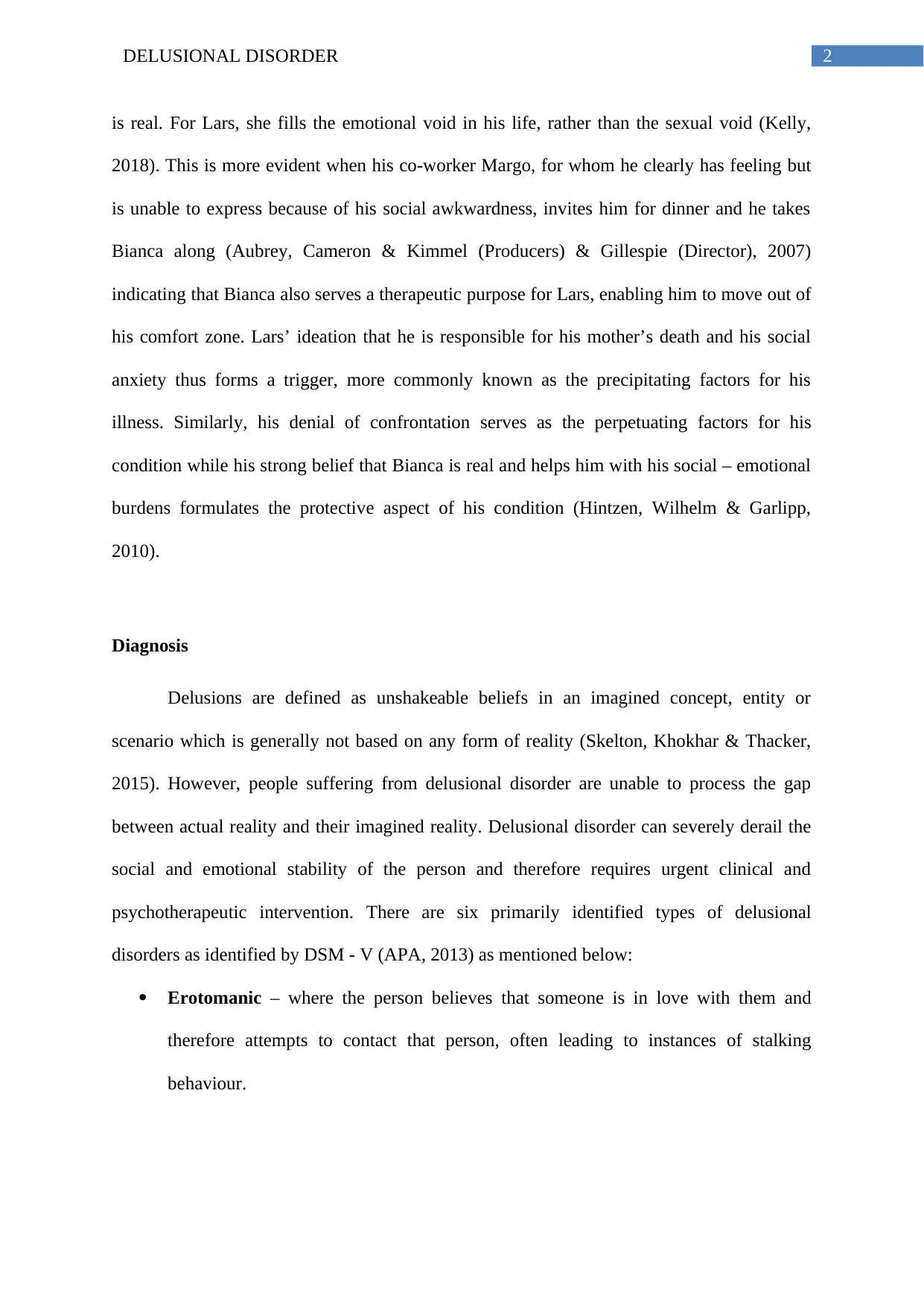
2DELUSIONAL DISORDER
is real. For Lars, she fills the emotional void in his life, rather than the sexual void (Kelly,
2018). This is more evident when his co-worker Margo, for whom he clearly has feeling but
is unable to express because of his social awkwardness, invites him for dinner and he takes
Bianca along (Aubrey, Cameron & Kimmel (Producers) & Gillespie (Director), 2007)
indicating that Bianca also serves a therapeutic purpose for Lars, enabling him to move out of
his comfort zone. Lars’ ideation that he is responsible for his mother’s death and his social
anxiety thus forms a trigger, more commonly known as the precipitating factors for his
illness. Similarly, his denial of confrontation serves as the perpetuating factors for his
condition while his strong belief that Bianca is real and helps him with his social – emotional
burdens formulates the protective aspect of his condition (Hintzen, Wilhelm & Garlipp,
2010).
Diagnosis
Delusions are defined as unshakeable beliefs in an imagined concept, entity or
scenario which is generally not based on any form of reality (Skelton, Khokhar & Thacker,
2015). However, people suffering from delusional disorder are unable to process the gap
between actual reality and their imagined reality. Delusional disorder can severely derail the
social and emotional stability of the person and therefore requires urgent clinical and
psychotherapeutic intervention. There are six primarily identified types of delusional
disorders as identified by DSM - V (APA, 2013) as mentioned below:
Erotomanic – where the person believes that someone is in love with them and
therefore attempts to contact that person, often leading to instances of stalking
behaviour.
is real. For Lars, she fills the emotional void in his life, rather than the sexual void (Kelly,
2018). This is more evident when his co-worker Margo, for whom he clearly has feeling but
is unable to express because of his social awkwardness, invites him for dinner and he takes
Bianca along (Aubrey, Cameron & Kimmel (Producers) & Gillespie (Director), 2007)
indicating that Bianca also serves a therapeutic purpose for Lars, enabling him to move out of
his comfort zone. Lars’ ideation that he is responsible for his mother’s death and his social
anxiety thus forms a trigger, more commonly known as the precipitating factors for his
illness. Similarly, his denial of confrontation serves as the perpetuating factors for his
condition while his strong belief that Bianca is real and helps him with his social – emotional
burdens formulates the protective aspect of his condition (Hintzen, Wilhelm & Garlipp,
2010).
Diagnosis
Delusions are defined as unshakeable beliefs in an imagined concept, entity or
scenario which is generally not based on any form of reality (Skelton, Khokhar & Thacker,
2015). However, people suffering from delusional disorder are unable to process the gap
between actual reality and their imagined reality. Delusional disorder can severely derail the
social and emotional stability of the person and therefore requires urgent clinical and
psychotherapeutic intervention. There are six primarily identified types of delusional
disorders as identified by DSM - V (APA, 2013) as mentioned below:
Erotomanic – where the person believes that someone is in love with them and
therefore attempts to contact that person, often leading to instances of stalking
behaviour.
⊘ This is a preview!⊘
Do you want full access?
Subscribe today to unlock all pages.

Trusted by 1+ million students worldwide
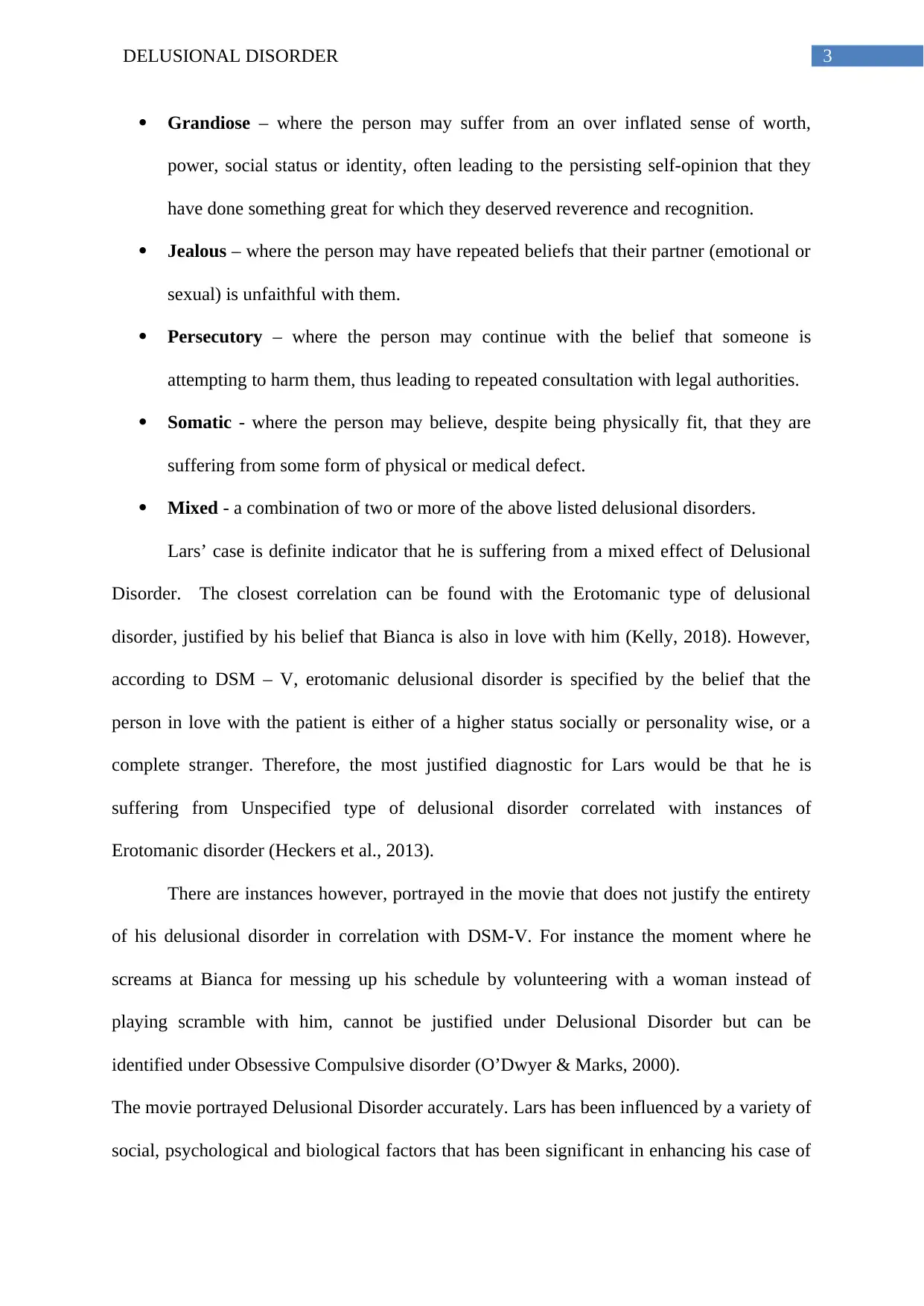
3DELUSIONAL DISORDER
Grandiose – where the person may suffer from an over inflated sense of worth,
power, social status or identity, often leading to the persisting self-opinion that they
have done something great for which they deserved reverence and recognition.
Jealous – where the person may have repeated beliefs that their partner (emotional or
sexual) is unfaithful with them.
Persecutory – where the person may continue with the belief that someone is
attempting to harm them, thus leading to repeated consultation with legal authorities.
Somatic - where the person may believe, despite being physically fit, that they are
suffering from some form of physical or medical defect.
Mixed - a combination of two or more of the above listed delusional disorders.
Lars’ case is definite indicator that he is suffering from a mixed effect of Delusional
Disorder. The closest correlation can be found with the Erotomanic type of delusional
disorder, justified by his belief that Bianca is also in love with him (Kelly, 2018). However,
according to DSM – V, erotomanic delusional disorder is specified by the belief that the
person in love with the patient is either of a higher status socially or personality wise, or a
complete stranger. Therefore, the most justified diagnostic for Lars would be that he is
suffering from Unspecified type of delusional disorder correlated with instances of
Erotomanic disorder (Heckers et al., 2013).
There are instances however, portrayed in the movie that does not justify the entirety
of his delusional disorder in correlation with DSM-V. For instance the moment where he
screams at Bianca for messing up his schedule by volunteering with a woman instead of
playing scramble with him, cannot be justified under Delusional Disorder but can be
identified under Obsessive Compulsive disorder (O’Dwyer & Marks, 2000).
The movie portrayed Delusional Disorder accurately. Lars has been influenced by a variety of
social, psychological and biological factors that has been significant in enhancing his case of
Grandiose – where the person may suffer from an over inflated sense of worth,
power, social status or identity, often leading to the persisting self-opinion that they
have done something great for which they deserved reverence and recognition.
Jealous – where the person may have repeated beliefs that their partner (emotional or
sexual) is unfaithful with them.
Persecutory – where the person may continue with the belief that someone is
attempting to harm them, thus leading to repeated consultation with legal authorities.
Somatic - where the person may believe, despite being physically fit, that they are
suffering from some form of physical or medical defect.
Mixed - a combination of two or more of the above listed delusional disorders.
Lars’ case is definite indicator that he is suffering from a mixed effect of Delusional
Disorder. The closest correlation can be found with the Erotomanic type of delusional
disorder, justified by his belief that Bianca is also in love with him (Kelly, 2018). However,
according to DSM – V, erotomanic delusional disorder is specified by the belief that the
person in love with the patient is either of a higher status socially or personality wise, or a
complete stranger. Therefore, the most justified diagnostic for Lars would be that he is
suffering from Unspecified type of delusional disorder correlated with instances of
Erotomanic disorder (Heckers et al., 2013).
There are instances however, portrayed in the movie that does not justify the entirety
of his delusional disorder in correlation with DSM-V. For instance the moment where he
screams at Bianca for messing up his schedule by volunteering with a woman instead of
playing scramble with him, cannot be justified under Delusional Disorder but can be
identified under Obsessive Compulsive disorder (O’Dwyer & Marks, 2000).
The movie portrayed Delusional Disorder accurately. Lars has been influenced by a variety of
social, psychological and biological factors that has been significant in enhancing his case of
Paraphrase This Document
Need a fresh take? Get an instant paraphrase of this document with our AI Paraphraser
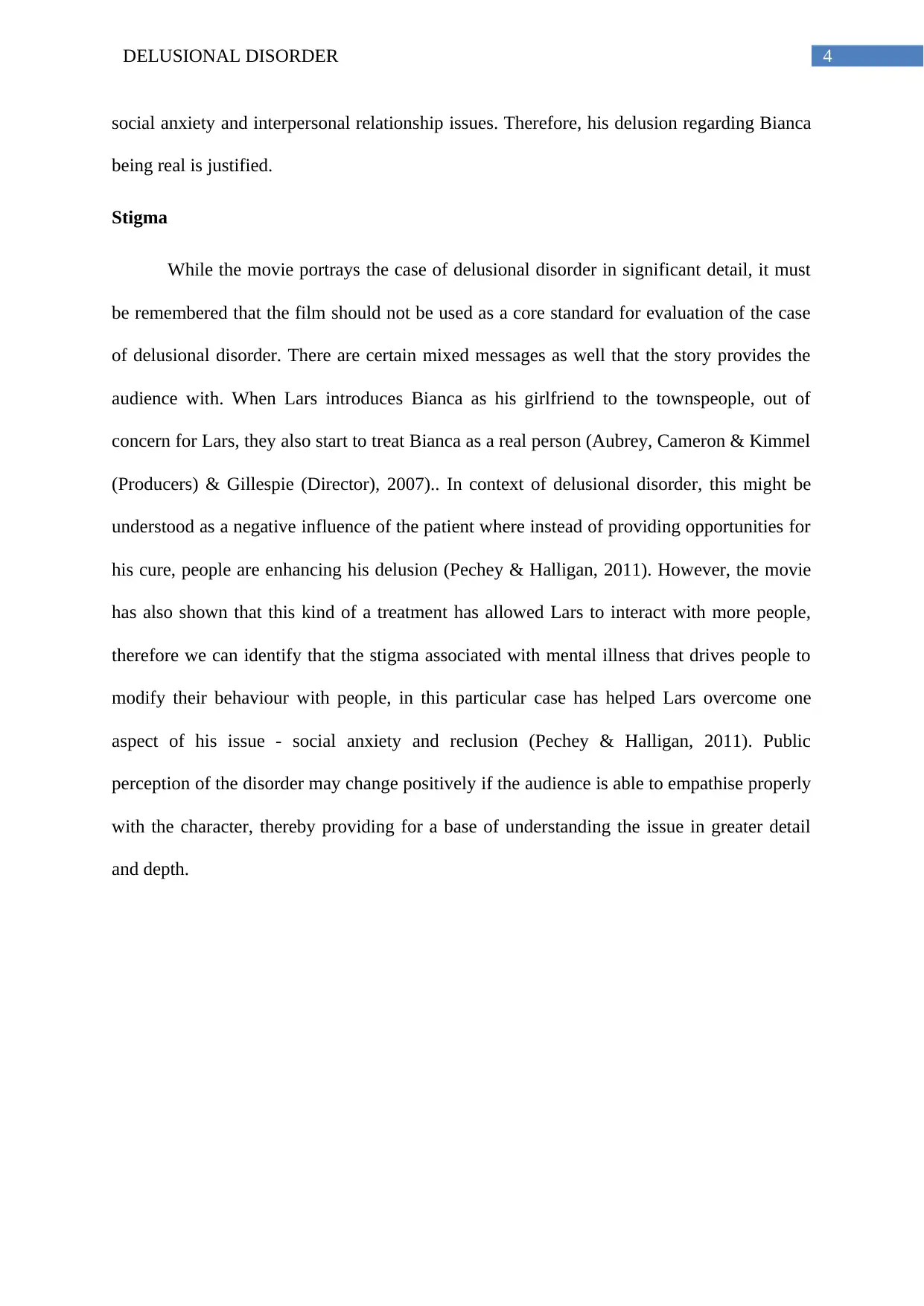
4DELUSIONAL DISORDER
social anxiety and interpersonal relationship issues. Therefore, his delusion regarding Bianca
being real is justified.
Stigma
While the movie portrays the case of delusional disorder in significant detail, it must
be remembered that the film should not be used as a core standard for evaluation of the case
of delusional disorder. There are certain mixed messages as well that the story provides the
audience with. When Lars introduces Bianca as his girlfriend to the townspeople, out of
concern for Lars, they also start to treat Bianca as a real person (Aubrey, Cameron & Kimmel
(Producers) & Gillespie (Director), 2007).. In context of delusional disorder, this might be
understood as a negative influence of the patient where instead of providing opportunities for
his cure, people are enhancing his delusion (Pechey & Halligan, 2011). However, the movie
has also shown that this kind of a treatment has allowed Lars to interact with more people,
therefore we can identify that the stigma associated with mental illness that drives people to
modify their behaviour with people, in this particular case has helped Lars overcome one
aspect of his issue - social anxiety and reclusion (Pechey & Halligan, 2011). Public
perception of the disorder may change positively if the audience is able to empathise properly
with the character, thereby providing for a base of understanding the issue in greater detail
and depth.
social anxiety and interpersonal relationship issues. Therefore, his delusion regarding Bianca
being real is justified.
Stigma
While the movie portrays the case of delusional disorder in significant detail, it must
be remembered that the film should not be used as a core standard for evaluation of the case
of delusional disorder. There are certain mixed messages as well that the story provides the
audience with. When Lars introduces Bianca as his girlfriend to the townspeople, out of
concern for Lars, they also start to treat Bianca as a real person (Aubrey, Cameron & Kimmel
(Producers) & Gillespie (Director), 2007).. In context of delusional disorder, this might be
understood as a negative influence of the patient where instead of providing opportunities for
his cure, people are enhancing his delusion (Pechey & Halligan, 2011). However, the movie
has also shown that this kind of a treatment has allowed Lars to interact with more people,
therefore we can identify that the stigma associated with mental illness that drives people to
modify their behaviour with people, in this particular case has helped Lars overcome one
aspect of his issue - social anxiety and reclusion (Pechey & Halligan, 2011). Public
perception of the disorder may change positively if the audience is able to empathise properly
with the character, thereby providing for a base of understanding the issue in greater detail
and depth.
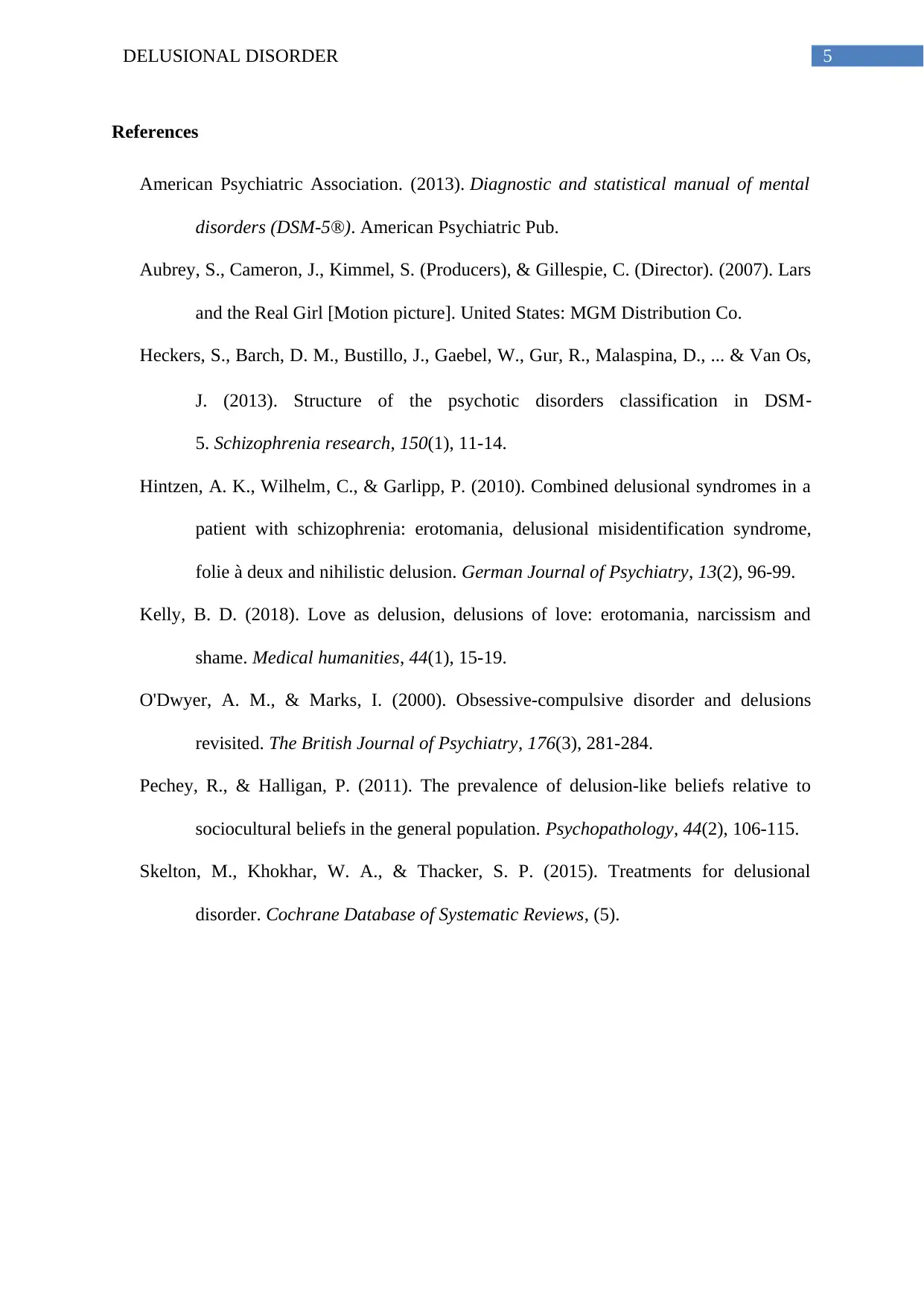
5DELUSIONAL DISORDER
References
American Psychiatric Association. (2013). Diagnostic and statistical manual of mental
disorders (DSM-5®). American Psychiatric Pub.
Aubrey, S., Cameron, J., Kimmel, S. (Producers), & Gillespie, C. (Director). (2007). Lars
and the Real Girl [Motion picture]. United States: MGM Distribution Co.
Heckers, S., Barch, D. M., Bustillo, J., Gaebel, W., Gur, R., Malaspina, D., ... & Van Os,
J. (2013). Structure of the psychotic disorders classification in DSM‐
5. Schizophrenia research, 150(1), 11-14.
Hintzen, A. K., Wilhelm, C., & Garlipp, P. (2010). Combined delusional syndromes in a
patient with schizophrenia: erotomania, delusional misidentification syndrome,
folie à deux and nihilistic delusion. German Journal of Psychiatry, 13(2), 96-99.
Kelly, B. D. (2018). Love as delusion, delusions of love: erotomania, narcissism and
shame. Medical humanities, 44(1), 15-19.
O'Dwyer, A. M., & Marks, I. (2000). Obsessive-compulsive disorder and delusions
revisited. The British Journal of Psychiatry, 176(3), 281-284.
Pechey, R., & Halligan, P. (2011). The prevalence of delusion-like beliefs relative to
sociocultural beliefs in the general population. Psychopathology, 44(2), 106-115.
Skelton, M., Khokhar, W. A., & Thacker, S. P. (2015). Treatments for delusional
disorder. Cochrane Database of Systematic Reviews, (5).
References
American Psychiatric Association. (2013). Diagnostic and statistical manual of mental
disorders (DSM-5®). American Psychiatric Pub.
Aubrey, S., Cameron, J., Kimmel, S. (Producers), & Gillespie, C. (Director). (2007). Lars
and the Real Girl [Motion picture]. United States: MGM Distribution Co.
Heckers, S., Barch, D. M., Bustillo, J., Gaebel, W., Gur, R., Malaspina, D., ... & Van Os,
J. (2013). Structure of the psychotic disorders classification in DSM‐
5. Schizophrenia research, 150(1), 11-14.
Hintzen, A. K., Wilhelm, C., & Garlipp, P. (2010). Combined delusional syndromes in a
patient with schizophrenia: erotomania, delusional misidentification syndrome,
folie à deux and nihilistic delusion. German Journal of Psychiatry, 13(2), 96-99.
Kelly, B. D. (2018). Love as delusion, delusions of love: erotomania, narcissism and
shame. Medical humanities, 44(1), 15-19.
O'Dwyer, A. M., & Marks, I. (2000). Obsessive-compulsive disorder and delusions
revisited. The British Journal of Psychiatry, 176(3), 281-284.
Pechey, R., & Halligan, P. (2011). The prevalence of delusion-like beliefs relative to
sociocultural beliefs in the general population. Psychopathology, 44(2), 106-115.
Skelton, M., Khokhar, W. A., & Thacker, S. P. (2015). Treatments for delusional
disorder. Cochrane Database of Systematic Reviews, (5).
⊘ This is a preview!⊘
Do you want full access?
Subscribe today to unlock all pages.

Trusted by 1+ million students worldwide
1 out of 6
Your All-in-One AI-Powered Toolkit for Academic Success.
+13062052269
info@desklib.com
Available 24*7 on WhatsApp / Email
![[object Object]](/_next/static/media/star-bottom.7253800d.svg)
Unlock your academic potential
Copyright © 2020–2025 A2Z Services. All Rights Reserved. Developed and managed by ZUCOL.
